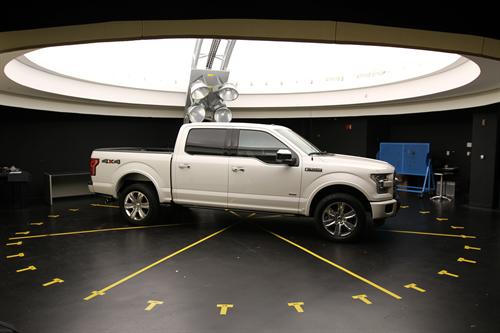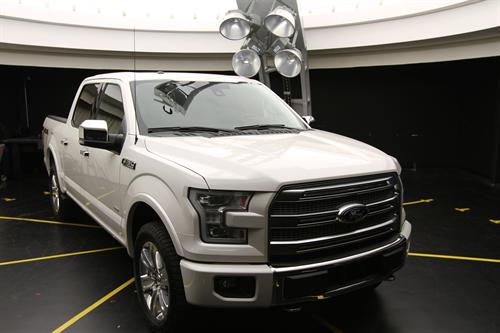
 Ford specially developed parts and extensively tested the 2015 Ford F-150 to resist fading and damage from harsh sunlight
Ford specially developed parts and extensively tested the 2015 Ford F-150 to resist fading and damage from harsh sunlight- F-150 interior designed with brims and brows to minimize glare and shield gauges in the instrument panel while adding lighting to see recessed items
- Advanced computer modeling and testing in Ford’s Lighting Lab helped ensure sunlight reflecting off interior surfaces will not wash out gauge and screen displays
Sunlight takes a toll on a vehicle, much like it does your skin and eyes. So Ford designed and tested its all-new F-150 pickup to ensure a fade-resistant exterior and interior and to minimize interior glare.
Much of the testing was done in the company’s Central Lab, where Ford engineers focus on making individual parts stronger and more durable. A device known as a ‘Thermatron’ simulates damaging UV sun rays and can be used over long periods of time on prototype parts to help identify the best design for production.
Anti-glare testing took place in Ford’s Visual Performance Evaluation Lab, also known as the Lighting Lab. The Lighting Lab can replicate almost any sunlight conditions from dawn to dusk, as well as changes to natural light caused by weather conditions.
“‘Built Ford Tough’ means more than surviving dirt, rocks and mud or towing heavy trailers,” said Cindy McComb, Materials Engineer, Central Lab. “Ford trucks need to look as good after five years of exposure to sun, wind and rain as they do when they leave the showroom floor. Testing these conditions for long term durability is our job in Central Lab.”
Even the F-150’s badge is tough tested. Both the iconic Blue Oval and F-150 badges endured 3,000 hours of sun-like conditions — the equivalent of five years. The three-piece badge also was exposed to temperatures as cold as 40 below Celsius followed by blasts of steam as hot as 100 degrees Celsius to help ensure chrome plating adheres to the badge so individual pieces won’t warp or crack.
The Central Lab also places individual exterior and interior parts on outside racks for six months at a time at a facility in central Florida – NASA also conducts tests there – to look for fading and other signs of degradation. The parts were examined under a special xenon light to reveal damage normally invisible to the human eye. Parts are only approved for production if they meet rigorous fade-resistance standards.
Direct sunlight does more than fade parts over time. It can also make it hard to see information displayed on gauges and display screens used in navigation and entertainment systems. The new F-150 instrument panel has shaded gauges to minimize glare. Ford engineers also used advanced computer aided design software to identify the least reflective materials for use throughout the Ford F-150 interior.
Certain gauges and instruments shaded from glare are enhanced with supplemental lighting to make them readable in their recessed positions.
Indirect glare from general daylight brightness can wash out navigation and entertainment screen displays, too. Engineers tested various colors for the new F-150, ultimately choosing those that are easy to see under bright conditions.
“By reducing indirect glare, the driver should almost never see a sun spot in the center screen or instrument cluster,” said Cary Diehl, human factors engineer at Ford. “In addition to testing gauges and screens under these conditions, we even looked at the amount of light given off by LEDs in secondary controls such as window and steering wheel switches, to ensure they would not be distracting to the driver when lit.”
During anti-glare testing in the Lighting Lab, which boasts 6,000 watts of lighting and a planetarium-like dome, Ford tested prototype F-150s under a full variety of simulated lighting conditions.
“Many F-150 customers will use their truck for work at outdoor jobsites. They don’t have the time or patience to deal with hard to read gauges or controls inside the truck,” said Mahendra Dassanayake, Ford lighting technical specialist. “Our work in the Lighting Lab ensures that despite almost any weather outside, customers will find it easy to read controls inside the truck today and years from tomorrow.”

You must be logged in to post a comment.